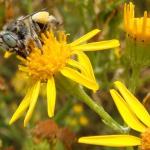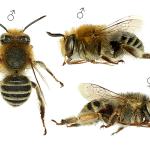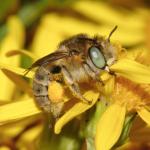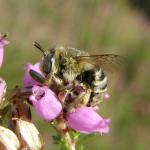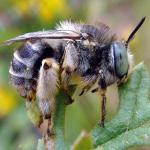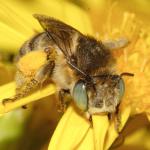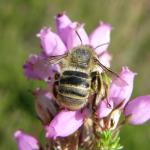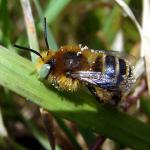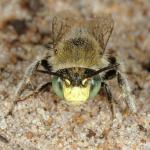Apis rotundata PANZER 1798; Anthophora saropoda LAMARCK 1817; Anthophora squalida LEPELETIER 1841
Both sexes can be identified by their yellow-marked faces and shrill hum. The male has pale green eyes in life, though this is a purely ephemeral character, the eyes becoming brownish-black after death.
Southern England and the Channel Islands (Sark). The species is widely distributed throughout much of Europe, from southern Fennoscandia to Spain, eastwards to at least Italy. However, this bee belongs to a group of species (sometimes placed in the genus Heliophila) which, in the western Palaearctic, closely resemble one another and are sometimes difficult to identify. A. bimaculata is the only representative of the group which occurs in Britain.
The bee is not regarded as being scarce or threatened.
Associated particularly with light sandy soils and, as such, is generally to be encountered inland on lowland heaths and commons, and on coastal dunes and landslips. Sometimes abundant where found, particularly in the vicinity of its nesting sites.
Univoltine; late June to mid September.
Nests usually occur in dense aggregations, often in exposed soil in either level surfaces or, more especially, slopes and cliff faces.
Bramble (Rubus fruticosus agg.), burdock (Arctium sp.), common fleabane (Pulicaria dysenterica), common knapweed (Centaurea nigra), dead-nettle (Lamium sp.), gypsywort (Lycopus europaeus), hawk's-beard (Crepis capillaris), hawkweed (Hieracium sp.), heaths (Erica sp.), privet (Ligustrum sp.), ragwort (Senecio jacobaea), sea bindweed (Calystegia soldanella), sea-lavender (Limonium sp,), spear thistle (Cirsium vulgare), thyme (Thymus sp.), viper's-bugloss (Echium vulgare), willowherb (Epilobium sp.) and wood sage (Teucrium scorodonia).
The cleptoparasitic bee Coelioxys rufescens has been reared from cells of A. bimaculata (F. Smith 1845) and is sometimes noted about nesting aggregations of the same species (pers. obs.). In Dorset, C. elongata has also been observed investigating nest burrows of the same host (G M Spooner, pers. comm.).
2012
Proofed: January 2012
Citing this page
Bees, Wasps & Ants Recording Society, 2013. Anthophora bimaculata. https://www.bwars.com/index.php?q=bee/apidae/anthophora-bimaculata.[Accessed Date (style 1st January 2013)]


